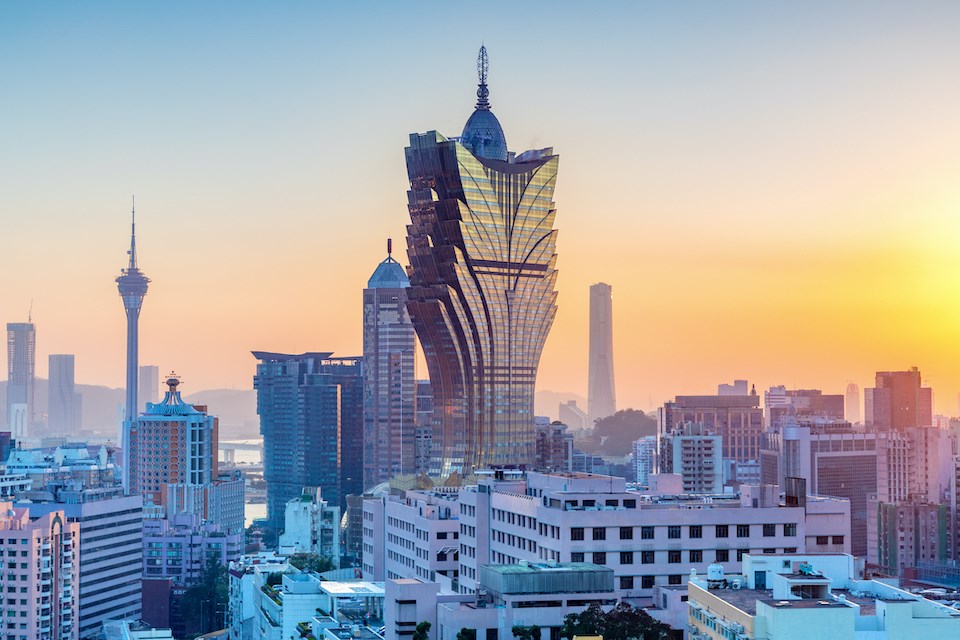Travel tips for visiting one of the most unique spots in Asia.
No trip over a week to Hong Kong is complete without a detour to Macau.
My recent trip from Vancouver to Hong Kong brimmed with highlights, from elevated gourmet dining experiences to ornate temple visits, breathtaking boat rides through Victoria Harbour and a gondola journey up to the Tian Tan Buddha – the second-largest seated outdoor bronze Buddha in the world sitting at 34 metres tall. And that’s just scratching the surface.
But my day trip to Macau offered a drastically different experience from anything I saw in Hong Kong. Also, my friend and I saw numerous attractions without paying for a single cab.
I spent about 10 days in Hong Kong and visited Macau toward the end of my trip while I was based in the Whampoa neighbourhood of Kowloon. The Mass Transit Railway (MTR) expedites commuters through the urban oasis and the trip from the Kowloon area to Hong Kong Island and several key locations takes about 20 minutes (see slides two and three).
You can pick up an Octopus Card to ride the MTR and city buses, and to make small purchases in convenience stores. A HKD 50 deposit is required (roughly C$8.72) but you can get that back when you return it at the end of your trip.
Getting from Hong Kong to Macau
To get to Macau, you can take a short, speedy ferry (about an hour) from Hong Kong Island to be transported to what feels like another world, even though it is only a close stint across the Pearl River estuary.
Turbojet tickets in the economy class range from C$30 to C$38 based on the time of day and week, while “Super Class” ones cost between C$64 to C$73 (see slide four).
My day started late and we hustled to get a ferry. We had to wait a bit because a couple of early sailings were booked (book your seats in advance to avoid missing sailings at busy times). Also, book your return ticket home when you buy your sailing over to ensure your trip back.
The process for taking the ferry is simple. People with large bags were directed to place them at the front, and signage instructed everyone to put on their seatbelts. BC Ferries passengers don’t face seat belt-requiring speeds, while these boats move quickly and can toss travellers back and forth in stormy or windy weather.
The outbound journey was pretty smooth but the return home was somewhat windy. I watched the boat bouncing on the waves with wide-eyed curiosity (and mild concern) while my travel buddy snoozed soundly beside me.
Alternatively, you can drive across the longest sea crossing on Earth, the Hong Kong–Zhuhai–Macau Bridge, which takes about 40 minutes. Visitors can also take advantage of a shuttle service between Hong Kong and Macau ports that runs 24 hours. Ticket prices range between C$5 for a one-way ticket during slower times and up to C$12 during peak hours.
Customs and Macau Fisherman’s Wharf
Ensure you bring your passport with you to visit Macau. It is also one of the special administrative regions of China, similar to Hong Kong. Visitors are required to go through customs when they come in and when they leave (see slide five).
Passing through customs is quite easy and you are a short stroll away from notable tourist attractions in all directions upon arrival. It isn’t hard to find out where the action is: massive casinos rise from the ground, offering ample opportunities to gamble, eat, shop, explore, and more.
I managed to visit the “Las Vegas of Asia” without gambling and did not find myself at a loss for things to do. A short stroll from the ferry terminal we passed the Sands Macao, which claims to be the “first Las Vegas-style casino” in the region (see slide six). It is situated along Macau Fisherman’s Wharf and features a variety of restaurants, shops, and places to snap photos (see slides seven and eight). We returned to this area later at night to enjoy some share plates. Some restaurant fronts had live music and were illuminated with lights and lanterns.
The Wharf also features an elegant covered pedestrian walkway, lined with palm trees and brightly coloured storefronts. Visitors can access restaurants and shops from this area or outside along the water but there are also some unique places to take photos along the walkway (see slides nine and 10).
We kept close to the water until we reached the closest spot to observe the serene Kun Iam Statue, above the Kun Iam Ecumenical Centre. The centre is on an artificial island connected by a 60-meter-long causeway (see slide 11).
The 50-ton bronze statue sits an impressive 20 meters high and embodies love, mercy and compassion. With UNESCO’s support, Portuguese architect and sculptor Cristina Rocha Leiria crafted the sculpture without a distinctive ethnicity to promote friendship among all peoples, according to the Kun lam Ecumenical Centre.
After a peaceful moment with Kun Lam, we stopped in some casinos, including the MGM Macau with its jaw-dropping floral installation, before stopping at some key Portuguese historical spots (see slide 12).
The Ruins of St. Paul in Macau
The Ruins of St. Paul is the most striking historical attraction in Portuguese Macau. The front of the church rises defiantly to the sky, while the remainder was destroyed by a devastating fire in 1835. On the day I visited, the robin’s egg-blue sky offered a dreamlike juxtaposition with the ancient structure, weathered by time and visited by countless eyes (see slide 13).
Visitors can go underneath the historic structure for free and see ancient scriptures, artworks, holy items, and even some skeletal remains. However, no photos are allowed in this area.
Most people tend to loiter around this attraction for a spell, as the front of the ruins offers a panoramic view of the sprawling urban oasis. We took several pictures on the steps and gazed at the shining casinos, the brightly-coloured Portuguese buildings, and the crowds of visitors making their way through the historic centre (see slide 14).
It’s worth exploring the area surrounding the ruins, too. Each street in the surrounding area contrasts the rest of Macau, with pastel or vibrantly-hued buildings and squares paved with cobblestones in the Portuguese style called calçada (see slides 15 and 16).
After leaving this area, our journey wound through the other side of Macau where we could observe people going about their daily lives. Shopkeepers have tiny altars with incense and other offerings outside of their storefronts, kept in little stone enclaves or up against the wall (see slides 17-19).
We stopped to have a Portuguese-Chinese-style lunch in this area. It was cheap; we split a couple of items in an air-conditioned eatery filled with easy laughter and families enjoying shared meals. We were prompted to go in by a smiling woman waving a menu. Vendors also offered free food samples on the street, which I gladly accepted.
From historic temples to massive casinos
Before we visited more attractions, we made a stop at the A-Ma Temple, originally built in 1488. It was near closing time so we weren’t permitted to see all of it but we were able to step inside the gate, smell the incense, and have a moment of respite from the hum of the bustling city outside. The exterior of the temple is striking, seemingly alive with depictions of historical and mythological figures, as well as two lions proudly guarding its entrance. It is dedicated to Mazu, the Chinese sea goddess and is considered one of Macau’s oldest temples (see slide 20).
The Macau Light Rapid Transit system takes visitors from the historic part of Macau to the area flooded with massive new casinos, resorts, and shopping centres. It was easy to use and you get to use what looks like a gambling chip to ride it (I couldn’t help but giggle; it was too perfect) (see slide 21).
The MTR is new and may remind you of riding TransLink’s SkyTrain (if it was brand new). It also stops at several casinos and you can get around quite easily (see slide 22).
Once you get to “the other side,” visions of Las Vegas may creep into your mind. Soaring, modern casinos overcome your view, starkly contrasting the temples and shops on the historic side.
After waltzing through a few sprawling resorts, we took a free shuttle back to the Wharf to enjoy dinner.
I ended up cabbing home from the ferry terminal at Hong Kong Island back to Kowloon, but transit was still running (it was just around midnight and my tired body requested a bed). My heart was full and my head was brimming with keepsakes that only I could see.
Thank you, Macau.
Find more information about exciting destinations in B.C. and across the globe, as well as travel deals and tips, by signing up for V.I.A.’s weekly travel newsletter The Wanderer. Since travel deals can sell out, find out the day they are posted by signing up for our daily Travel Deals newsletter.
Want to learn more about a specific destination or have a travel concern or idea you would like V.I.A. to write about? Email us at [email protected]. Send us stories about recent holidays that you’ve been on, or if you have any tips you think our readers should know about.







